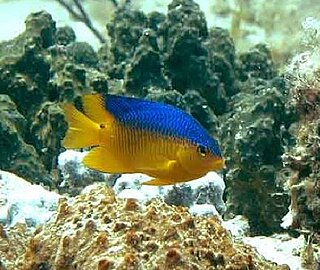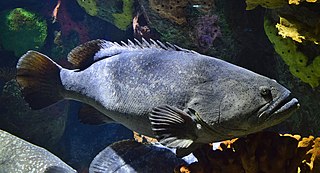
Pomacentridae is a family of ray-finned fish, comprising the damselfishes and clownfishes. This family were formerly placed in the order Perciformes but are now regarded as being incertae sedis in the subseries Ovalentaria in the clade Percomorpha. They are primarily marine, while a few species inhabit freshwater and brackish environments. They are noted for their hardy constitutions and territoriality. Many are brightly colored, so they are popular in aquaria.

El Niño–Southern Oscillation (ENSO) is a global climate phenomenon that emerges from variations in winds and sea surface temperatures over the tropical Pacific Ocean. Those variations have an irregular pattern but do have some semblance of cycles. The occurrence of ENSO is not predictable. It affects the climate of much of the tropics and subtropics, and has links (teleconnections) to higher-latitude regions of the world. The warming phase of the sea surface temperature is known as "El Niño" and the cooling phase as "La Niña". The Southern Oscillation is the accompanying atmospheric oscillation, which is coupled with the sea temperature change.

The giant grouper (Epinephelus lanceolatus), also known as the Queensland groper (grouper), brindle grouper or mottled-brown sea bass, is a species of marine ray-finned fish, a grouper from the subfamily Epinephelinae which is part of the family Serranidae, which also includes the anthias and sea basses. It has a wide Indo-Pacific distribution and is one of the largest extant species of bony fish.

Ogcocephalidae is a family of anglerfish specifically adapted for a benthic lifestyle of crawling about on the seafloor. Ogcocephalid anglerfish are sometimes referred to as batfishes, deep-sea batfishes, handfishes, and seabats. They are found in tropical and subtropical oceans worldwide. They are mostly found at depths between 200 and 3,000 m, but have been recorded as deep as 4,000 m (13,000 ft). A few species live in much shallower coastal waters and, exceptionally, may enter river estuaries.

The bulbous dreamer, or cosmoplitan dreamer, is a species of marine ray-finned fish belonging to the family Oneirodidae, the dreamers, a family of deep-sea anglerfishes. This fish has a circumglobal distribution in tropical and temperate oceans.

Microcosmus is a genus of tunicates in the family Pyuridae, containing the following species:

The Central Indo-Pacific is a biogeographic region of Earth's seas, comprising the tropical waters of the western Pacific Ocean, the eastern Indian Ocean, and the connecting seas.

Clavus exasperatus, common name the exasperating turrid, is a species of sea snail, a marine gastropod mollusk in the family Drilliidae.

Euastacus spinifer is a species of freshwater crayfish endemic to Australia that belongs to the family Parastacidae.
Walkeria tuberosa is a species of colonial bryozoan in the order Ctenostomatida. It is native to the Mediterranean Sea, and has spread to the Red Sea and the Indo-Pacific region.
Pterygotrigla multiocellata, the antrorse spined gurnard, is a species of ray-finned fish belonging to the family Triglidae, the gurnards and sea robins. This fish is found in the Indo-Pacific region where it has been recorded from Japan, Saipan, and the eastern and western tropical waters off Australia.

Ascidia incrassata is a sea squirt in the family Ascidiidae and was first described in 1878 by Camill Heller.
Ascidia caudata is a sea squirt in the family Ascidiidae and was first described in 1878 by Camill Heller.
Caligus infestans is a species of sea louse in the family, Caligidae, first described by Camill Heller in 1865.
Diogenes avarus is a species of left-handed hermit crab first described in 1865 by Camill Heller.

Herdmania grandis is a species of sea-squirt in the family Pyuridae.

Asterocarpa humilis is a species of ascidian tunicate first described in 1878 as Styela humilis by Camill Heller.
Herdmania pallida is a species of sea-squirt in the family Pyuridae.

Pyura gibbosa is a species of sea-squirt in the family, Pyuridae, and was first described in 1878 as Cynthia gibbosa by Camill Heller.













